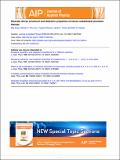Disorder driven structural and dielectric properties of silicon substituted strontium titanate
Date
17/07/2015Metadata
Show full item recordAbstract
A systematic study on structural, microstructural, optical, dielectric, and electrical properties of phase-pure silicon-modified SrTiO3 polycrystalline electroceramics synthesized using high energy solid state reaction techniques is presented. The asymmetry and splitting in the x-ray diffractometer spectra and the observation of first order transverse optical TO2 and longitudinal optical LO4 modes in Raman spectra (nominally forbidden) revealed the distortion in the cubic lattice as a result of breaking of inversion symmetry due to doping. A bandgap Eg of 3.27 eV was determined for the sample by diffuse reflectance spectroscopy. A high dielectric constant of -400 and very low dielectric loss of -0.03 were obtained at 100 kHz near ambient conditions. The temperature dependence of the dielectric data displayed features of high temperature relaxor ferroelectric behavior as evidence of existence of polar nano-regions. The ac conductivity as a function of frequency showed features typical of universal dynamic response and obeyed a power law σac = σdc+Aωn . The temperature dependent dc conductivity followed an Arrhenius relation with activation energy of 123 meV in the 200–500 K temperature range. The linear dielectric response of Pt/SrSi0.03Ti0.97O3/Pt dielectric capacitors was well characterized. The measured leakage current was exceptionally low, 13 nA/cm2 at 8.7 kV/cm, revealing an interface blocked bulk conduction mechanism.
Citation
Dugu , S , Pavunny , S P , Sharma , Y , Scott , J F & Katiyar , R S 2015 , ' Disorder driven structural and dielectric properties of silicon substituted strontium titanate ' , Journal of Applied Physics , vol. 118 , no. 3 , 034105 . https://doi.org/10.1063/1.4927042
Publication
Journal of Applied Physics
Status
Peer reviewed
ISSN
0021-8979Type
Journal article
Rights
© 2015 AIP Publishing LLC. This work is made available online in accordance with the publisher’s policies. This is the final published version of the work, which was originally published at: https://dx.doi.org/10.1063/1.4927042
Description
Financial support from NSF Grant No. NSF-RII-0701525 was acknowledged. S.D. is thankful to DOD for doctoral fellowship under Grant No. W911NF-11-1-0204. S.P.P. is grateful to NSF for financial assistance under Grant No: NSF-EFRI RESTOR # 1038272.Items in the St Andrews Research Repository are protected by copyright, with all rights reserved, unless otherwise indicated.

